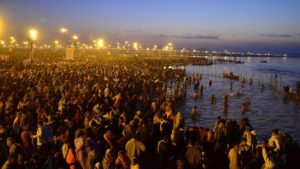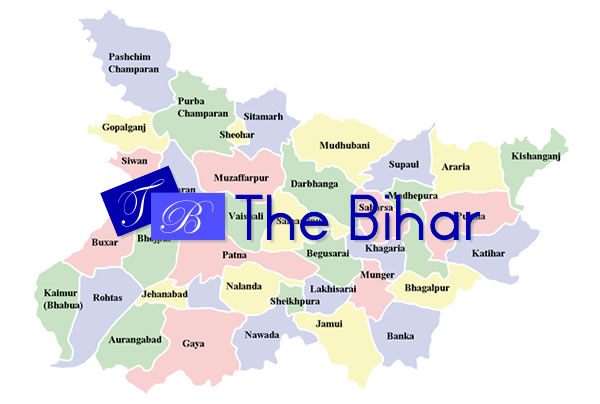Bathing in Ganga can expose people to high levels of faecal coliform bacteria
3 min read A dip in the Ganga at Sangam, where the Yamuna meets it in Allahabad, could expose people to levels of the faecal coliform (FC) that are 5-13 times the permissible limit, official data from 2017 shows. This limit is unsafe for bathing.
A dip in the Ganga at Sangam, where the Yamuna meets it in Allahabad, could expose people to levels of the faecal coliform (FC) that are 5-13 times the permissible limit, official data from 2017 shows. This limit is unsafe for bathing.
FC bacteria, such as E.coli, are found in excreta that contaminates water through untreated sewerage. The permissible limit for FC is 2,500 MPN (most probable number) /100 ml, while the desirable level is 500 MPN/100 ml.
Pollution levels were high centred around holy sites, where high population density and activities add to the pollution load, shows Central Pollution Control Board (CPCB) data.
In Uttar Pradesh, 50% of the 16 stations for which latest FC data is available for 2018, did not meet desired standards.
For Bihar, 88% of the stations did not meet standards.
Some of the most polluted stretches were Kanpur, Allahabad and Varanasi in UP. At the Jajmau pumping station in Kanpur in 2017, FC levels were 10- 23 times the limit. This not a one off spike. In 2011, too, the station recorded FC levels ranging from 4,000 to 93,000 MPN/ 100 ml.
At Malviya bridge in Varanasi, the FC levels are 9-20 times the limit.
Watch: Elephant saved from drowning in Ganga in 2-hour rescue operation
In 2011, values ranged between 13-19 times the limit at the Malviya bridge station.
At Ramrekhaghat in Buxar, the FC levels in August 2017 peaked at 160,00,000, which is 6,400 times the FC norm.
An analysis of 2017 data from state pollution control boards in five states – Uttarakhand, Uttar Pradesh, Bihar, Jharkhand and West Bengal — through which the Ganga flows shows that water quality in the river was abysmal in Bihar and Uttar Pradesh in 2017 mostly because of faecal pollution.
Data for West Bengal was not available but an earlier analysis of Ganga water quality data from 2016 showed high levels of FC contamination.
Most projects to treat sewerage were sanctioned in the past year and have yet to show results.
Out of 94 stations that dot the Ganga’s main stem, readings from 76 stations was available. Data for one station in Jharkhand showed satisfactory water quality.
The CPCB data shows that the Ganga is cleanest as it flows from its source in Uttarakhand, with all stations in the state reporting satisfactory water quality.
In Uttar Pradesh, 65% of the stations had unsatisfactory water quality in 2017. In Bihar, 76% of the stations recorded unsatisfactory water quality, with no station reporting satisfactory water quality.
“There is an index for air quality, but it is more difficult to develop an index for water,” a CPCB official, who spoke on condition of anonymity, said. “It is different from an environmental point of view and from a human health perspective. Fecal coliform is dangerous to human health.”
Read: Ganga water cleaner than it was in 1986?
Anil Kumar Singh, an official at the UP Pollution Control Board, said that the high levels of pollution were due to discharge of untreated domestic waste. “Treatment capacity [in Varanasi] is about a quarter of the total discharge,” he said.
This is true of the entire Ganga main stem. Sewage treatment capacity in the 97 major towns on the river is less than half of the total sewage generated.
The largescale diversion of water has made the problem worse as depleting water flow raises the concentration of pollutants.
The Namami Gange programme, launched in May 2015, earmarked Rs 20,000 crore for the rejuvenation of the river. Though Rs 19, 630 crore has been approved for funding 192 projects, only 49 projects have been completed so far.
Pollution levels fluctuate, with higher water flow during and after monsoon diluting contaminant levels. “However, pollution has reached such levels that rivers like the Yamuna are polluted throughout the year,” the CPCB official said.
The data from programmes for cleaning the Ganga are incomplete and not independently verified. “The data is questionable, but since no one else apart from the pollution control boards collect the data, no one can challenge it,” said RK Sinha, an environment activist hailing from Bihar who has worked on Ganga water quality for over three decades. “The regulatory authority and monitoring authority cannot be the same.”
Courtesy: Hindustan Times


